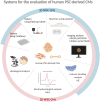Systems for the Functional Evaluation of Human Heart Tissues Derived from Pluripotent Stem Cells
- PMID: 35303744
- PMCID: PMC9216506
- DOI: 10.1093/stmcls/sxac022
Systems for the Functional Evaluation of Human Heart Tissues Derived from Pluripotent Stem Cells
Abstract
Human pluripotent stem cells (hPSCs) are expected to be a promising cell source in regenerative medicine and drug discovery for the treatment of various intractable diseases. An approach for creating a 3-dimensional (3D) structure from hPSCs that mimics human cardiac tissue functions has made it theoretically possible to conduct drug discovery and cardiotoxicity tests by assessing pharmacological responses in human cardiac tissues by a screening system using a compound library. The myocardium functions as a tissue composed of organized vascular networks, supporting stromal cells and cardiac muscle cells. Considering this, the reconstruction of tissue structure by various cells of cardiovascular lineages, such as vascular cells and cardiac muscle cells, is desirable for the ideal conformation of hPSC-derived cardiac tissues. Heart-on-a-chip, an organ-on-a-chip system to evaluate the physiological pump function of 3D cardiac tissues might hold promise in medical researchs such as drug discovery and regenerative medicine. Here, we review various modalities to evaluate the function of human stem cell-derived cardiac tissues and introduce heart-on-a-chip systems that can recapitulate physiological parameters of hPSC-derived cardiac tissues.
Keywords: cardiomyocyte; cardiotoxicity; organ-on-a-chip; pluripotent stem cell.
© The Author(s) 2022. Published by Oxford University Press.
Figures



Similar articles
-
Human pluripotent stem cell-derived cardiac stromal cells and their applications in regenerative medicine.Stem Cell Res. 2020 May;45:101831. doi: 10.1016/j.scr.2020.101831. Epub 2020 Apr 27. Stem Cell Res. 2020. PMID: 32446219 Free PMC article. Review.
-
Generating 3D human cardiac constructs from pluripotent stem cells.EBioMedicine. 2022 Feb;76:103813. doi: 10.1016/j.ebiom.2022.103813. Epub 2022 Jan 27. EBioMedicine. 2022. PMID: 35093634 Free PMC article. Review.
-
Development and application of 3D cardiac tissues derived from human pluripotent stem cells.Drug Metab Pharmacokinet. 2025 Feb;60:101049. doi: 10.1016/j.dmpk.2024.101049. Epub 2025 Jan 4. Drug Metab Pharmacokinet. 2025. PMID: 39847979 Review.
-
Application of human pluripotent stem cells and pluripotent stem cell-derived cellular models for assessing drug toxicity.Expert Opin Drug Metab Toxicol. 2019 Jan;15(1):61-75. doi: 10.1080/17425255.2019.1558207. Epub 2018 Dec 17. Expert Opin Drug Metab Toxicol. 2019. PMID: 30526128 Review.
-
Biomarkers of Human Pluripotent Stem Cell-Derived Cardiac Lineages.Trends Mol Med. 2017 Jul;23(7):651-668. doi: 10.1016/j.molmed.2017.05.001. Epub 2017 May 30. Trends Mol Med. 2017. PMID: 28576602 Review.
Cited by
-
Advancing Cardiovascular Drug Screening Using Human Pluripotent Stem Cell-Derived Cardiomyocytes.Int J Mol Sci. 2024 Jul 21;25(14):7971. doi: 10.3390/ijms25147971. Int J Mol Sci. 2024. PMID: 39063213 Free PMC article.
-
A Dexamethasone-Loaded Polymeric Electrospun Construct as a Tubular Cardiovascular Implant.Polymers (Basel). 2023 Nov 6;15(21):4332. doi: 10.3390/polym15214332. Polymers (Basel). 2023. PMID: 37960012 Free PMC article.
-
The Current State of Realistic Heart Models for Disease Modelling and Cardiotoxicity.Int J Mol Sci. 2024 Aug 24;25(17):9186. doi: 10.3390/ijms25179186. Int J Mol Sci. 2024. PMID: 39273136 Free PMC article. Review.
References
-
- Virani SS, Alonso A, Benjamin EJ, et al. . Heart disease and stroke statistics—2020 update: a report from the American Heart Association. Circulation. 2020; 141(9):e139-e596 - PubMed
-
- Lechat P. The Cardiac Insufficiency Bisoprolol Study II (CIBIS-II): a randomised trial. Lancet. 1999;353:9-131. - PubMed

